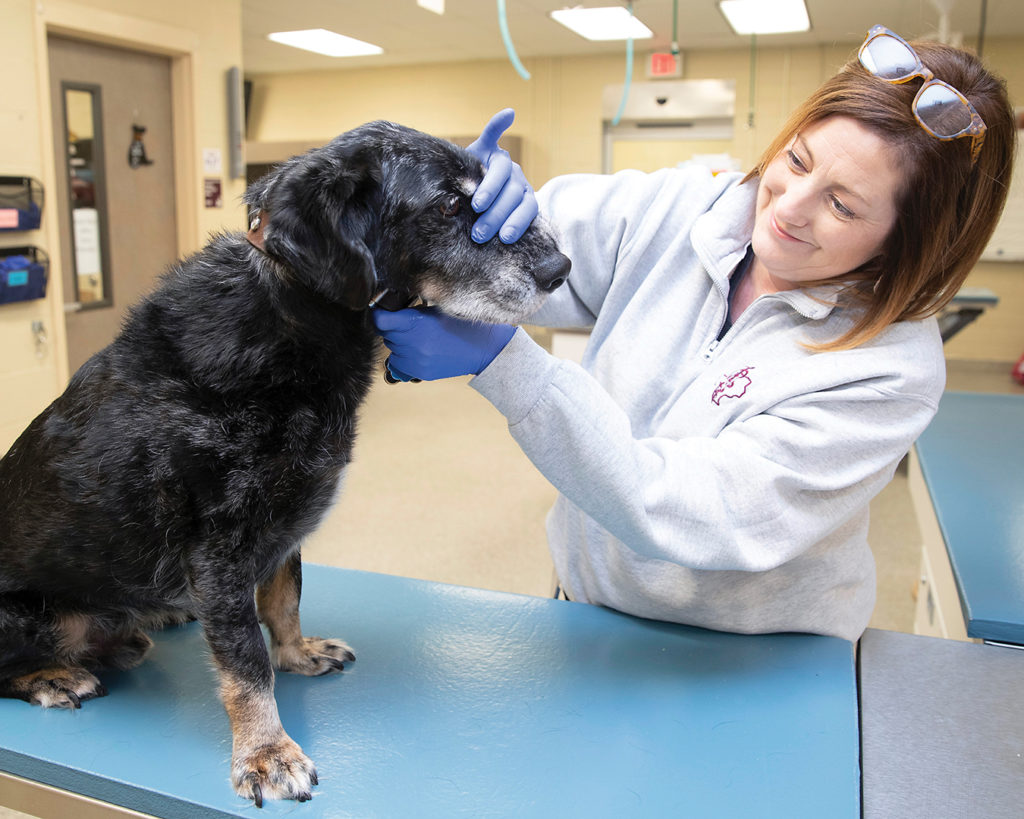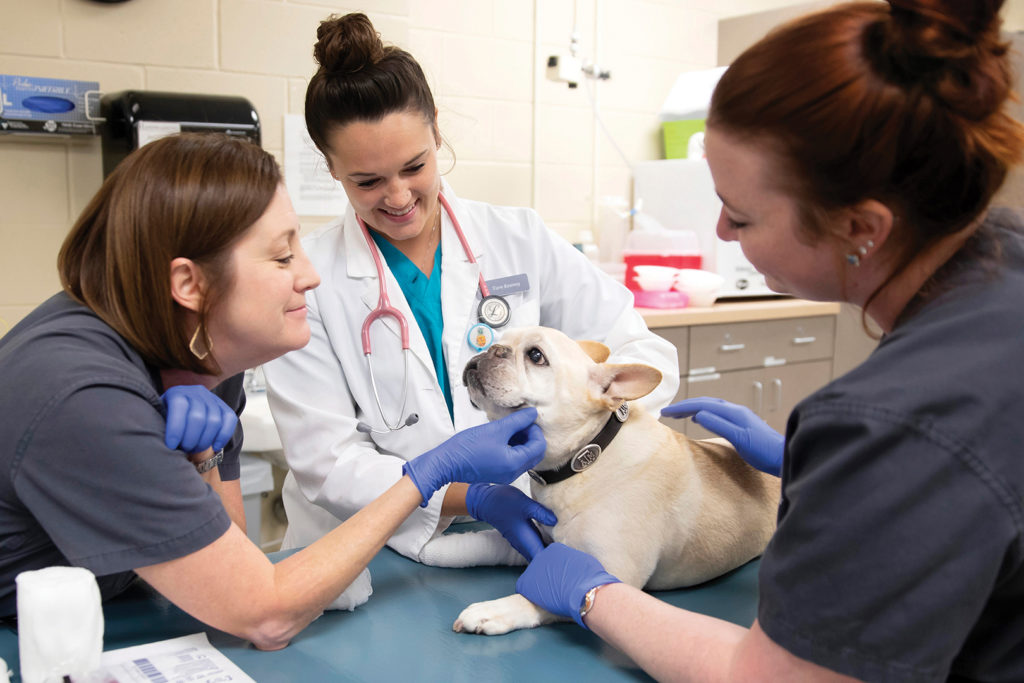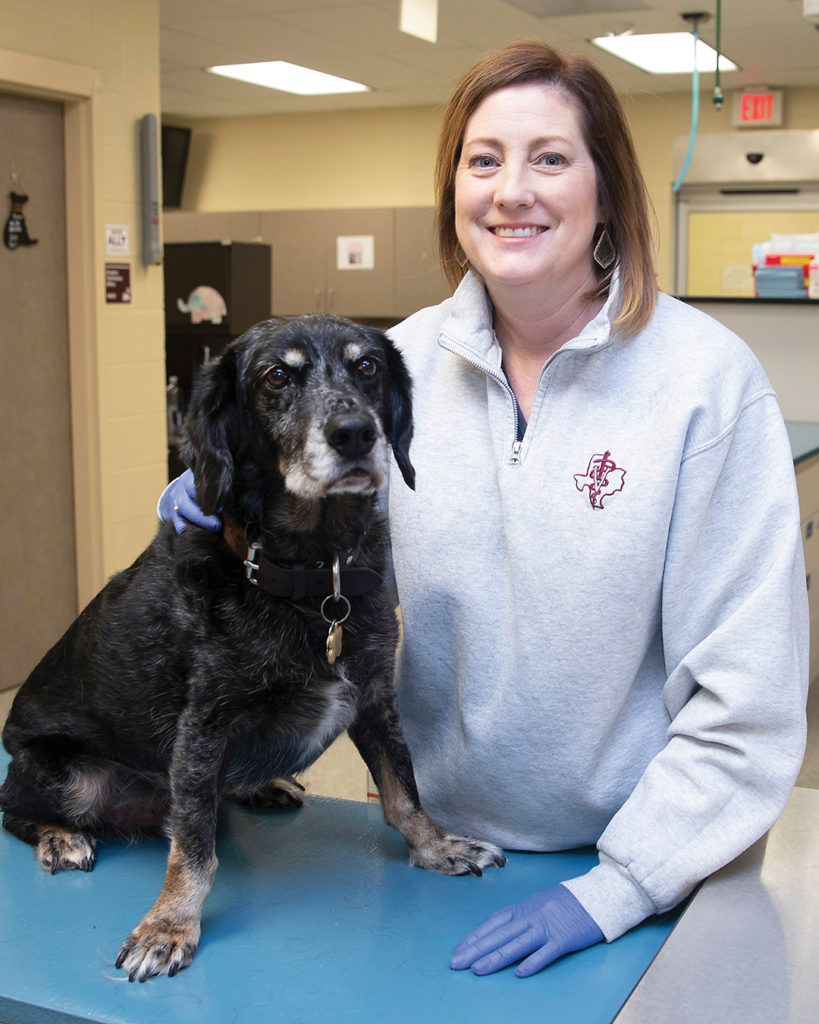All in a Day’s Work
Veterinary technician Dana Whitaker has a busy career in the Small Animal Hospital’s soft tissue surgery service, but she finds joy in the little things, such as getting to work with the animals she loves.

At the Texas A&M Small Animal Hospital (SAH), veterinary technicians work behind the scenes to keep the hospital going.
From ensuring pets stay comfortable to assisting veterinarians in surgery, veterinary technicians are always ready and willing to help.
According to Dana Whitaker, a veterinary technician in the SAH’s soft tissue surgery service, they “grease the wheels” between services to keep everything running smoothly.
“We make sure everything remains harmonious and moving along as it should,” Whitaker said. “We do everything from making sure the pets are happy while they’re here to doing any of the diagnostic work that needs to be done.”
Working in the soft tissue surgery service is more than just preparing for and cleaning up after surgeries; for Whitaker, every day also involves teaching both the Texas A&M College of Veterinary Medicine & Biomedical Sciences (CVM) veterinary students and the veterinary technician students who come from Blinn College and other veterinary technician programs to learn.
“The students have been in the classrooms for years,” Whitaker said. “They come to the clinic floor and it’s like a brand-new world to them.
“We help students adjust and educate them, help them apply all of those things they’ve read about to real life,” she explained. “You can read about these procedures, but actually doing them is a whole other story.”
Along with teaching technical skills, Whitaker focuses on helping students know when they need to consult with another veterinarian, because, according to Whitaker, it is especially important to know when to ask for help in a busy atmosphere like the SAH, where services deal with serious cases every day. In 2018, the soft tissue surgery department had 420 surgery cases, not including wound care, bandage changes, or helping other services.
Veterinary technicians have very demanding careers with long hours, emotional days, and little downtime at work. However, many people still feel called to this career path because of their love for animals.
With a background in retail and customer service, Whitaker never planned on becoming a veterinary technician until she got her first dog, Reilly.
“I had her spayed and I could not handle not knowing what was going on with her,” Whitaker said. “That’s where my interest in veterinary medicine came in.”

After discovering this new passion, she decided to pursue a veterinary technician degree at Bel-Rea Institute of Animal Technology, where she graduated in 2005. She then began working as an anesthesia technician at the SAH, later moving to soft tissue surgery.
Sadly, Reilly developed brain cancer when she was 8 years old. SAH veterinary surgeons and oncologists worked together to remove Reilly’s tumor and begin chemotherapy, but Whitaker made the difficult decision to stop treatment when she noticed that the medicine changed Reilly’s personality. Reilly crossed the Rainbow Bridge in June 2009.
Though saddened by the loss, Whitaker said she felt comforted by the compassion her SAH coworkers showed throughout the case. She uses the experience to better empathize with clients who are dealing with a similar loss.
This ability to comfort others has also helped during her five deployments with the Texas A&M Veterinary Emergency Team (VET) since 2009. As a founding member of the VET, Whitaker has spent countless hours working with Texas Task Force 1 Urban Search and Rescue canines and their handlers, as well as animals impacted by natural or man-made disasters.
“For every deployment I have been on, I still remember the pets we saw,” Whitaker said. “I went to Bastrop, our first deployment with the VET. This one cat came in. He was a little bit singed, but he wasn’t burned. His whiskers were curled from the heat, but he didn’t have any wounds.
“This cat had a collar on with a tag, with his name and his phone number, and he only had the singed whiskers. It was a celebration of, ‘Yay! This one is going to find his people!’ Things like that stick with me, when you have that great positive outcome.”
A true animal lover, Whitaker said she often recognizes owners by their pets. Being able to bond with her animal patients is part of what makes the veterinary technician job so appealing to her.

“I can tell you name after name of pets we’ve helped; every case sticks with me,” she said.
Whitaker, herself, has multiple pets, including a dog named Crockett, who has proven to be a learning experience.
“He’s cute, but he’s so naughty,” Whitaker said with a laugh. “I used to be the technician saying, ‘I can’t believe these people have this naughty dog. He’s so bad!’ Now I have the same dog, and I get it. I have a little bit more compassion for those clients who are like, ‘I know he’s terrible but I just love him.’”
Whitaker’s talents as a veterinary technician have been recognized many times, most notably when she was awarded the Texas Veterinary Medical Association’s Veterinary Technician of the Year Award in 2016. Though her job can be demanding and exhausting, she said she still loves working at the SAH.
“I’m working full cases, with cutting-edge technology, and with brilliant surgeons, clinicians, and anesthesiologists,” she said. “I don’t think it’s anything I could ever get anywhere else.”
She also said the SAH has a strong sense of family among coworkers, including the students who pass through during their fourth-year clinical rotations.
“I really love working with the students because I feel like it keeps me young,” she said.
Luckily for her, the SAH will see no shortage of students in the coming years, all excited to learn from experienced and talented veterinary technicians like Whitaker.
As new technologies and treatments are developed, veterinary technicians at the SAH will have even more opportunities to provide students with the best education possible and to provide pets with the best care possible.
###
Note: This story originally appeared in the Fall 2019 edition of CVMBS Today.
For more information about the Texas A&M College of Veterinary Medicine & Biomedical Sciences, please visit our website at vetmed.tamu.edu or join us on Facebook, Instagram, and Twitter.
Contact Information: Jennifer Gauntt, Director of CVMBS Communications, Texas A&M College of Veterinary Medicine & Biomedical Sciences; jgauntt@cvm.tamu.edu; 979-862-4216



